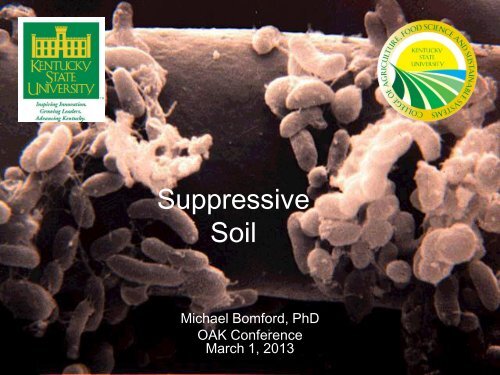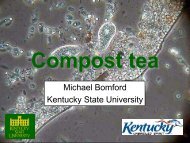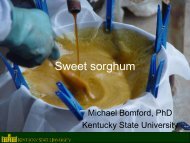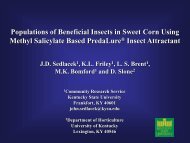Disease Suppressive Soil
Disease Suppressive Soil
Disease Suppressive Soil
You also want an ePaper? Increase the reach of your titles
YUMPU automatically turns print PDFs into web optimized ePapers that Google loves.
<strong>Suppressive</strong><br />
<strong>Soil</strong><br />
Michael Bomford, PhD<br />
OAK Conference<br />
March 1, 2013
-Jerome Belanger
Crop disease caused by<br />
fungi and bacteria<br />
• Average 7-15% yield<br />
loss globally<br />
• >$4 billion loss annually<br />
in US alone<br />
• 90% soilborne
Cure Worse than the <strong>Disease</strong>?<br />
• Methyl bromide fumigation<br />
– Effective control of soil-borne diseases<br />
– Highly toxic, leading to respiratory, kidney, and<br />
neurological diseases in humans, sometimes fatal<br />
– Potential carcinogen<br />
– Ozone depleting chemical<br />
– Phased out by most countries in early 2000s; Down to<br />
2.2% of 1991 use level in USA
Non-chemical Control Options<br />
• Host resistance<br />
• Crop rotation<br />
• Plant spacing<br />
• Tillage<br />
• <strong>Soil</strong> solarization<br />
• Biocontrol<br />
• <strong>Suppressive</strong> soils<br />
– Native<br />
– Induced
<strong>Suppressive</strong><br />
<strong>Soil</strong>s<br />
• All natural soils are<br />
somewhat<br />
suppressive<br />
– Physical attributes<br />
– Chemical attributes<br />
– Microbiological activity<br />
• Transferred between<br />
soils by introduction of<br />
small quantities of<br />
suppressive soil<br />
• Effect destroyed by<br />
pasteurization
<strong>Suppressive</strong> <strong>Soil</strong>s<br />
• <strong>Soil</strong> microfauna effect<br />
• Destroy soil-borne pathogens<br />
– (e.g. take-all of wheat after years<br />
without rotation)<br />
• Destroy weed seeds<br />
– (e.g. soils from European weed<br />
place of origin 30-40% more<br />
weed suppressive than PNW<br />
soils)<br />
• Destroy soil-dwelling<br />
arthropods<br />
– (e.g. entomopathogenic<br />
nematodes)
Take-all decline: <strong>Disease</strong> increases, then<br />
declines after years without rotation<br />
Berendsen et al. 2012. The rhizosphere microbiome<br />
and plant health. Trends in Plant Science 17: 478-486.
Mendes et al. 2011. Deciphering the Rhizosphere Microbiome<br />
for <strong>Disease</strong> <strong>Suppressive</strong> <strong>Soil</strong>s. Science 332: 1097.
Sugar beets growing in<br />
soil inoculated with<br />
Rhizoctonia solani<br />
Mendes et al. 2011. Deciphering the Rhizosphere Microbiome<br />
for <strong>Disease</strong> <strong>Suppressive</strong> <strong>Soil</strong>s. Science 332: 1097.
<strong>Suppressive</strong> soil<br />
from sugar beet field<br />
that previously<br />
suffered R. solani<br />
outbreak<br />
Mendes et al. 2011. Deciphering the Rhizosphere Microbiome<br />
for <strong>Disease</strong> <strong>Suppressive</strong> <strong>Soil</strong>s. Science 332: 1097.
Conducive<br />
soil from field<br />
margins<br />
Mendes et al. 2011. Deciphering the Rhizosphere Microbiome<br />
for <strong>Disease</strong> <strong>Suppressive</strong> <strong>Soil</strong>s. Science 332: 1097.
90% Conducive<br />
mixed with 10%<br />
<strong>Suppressive</strong><br />
Mendes et al. 2011. Deciphering the Rhizosphere Microbiome<br />
for <strong>Disease</strong> <strong>Suppressive</strong> <strong>Soil</strong>s. Science 332: 1097.
<strong>Suppressive</strong><br />
soil heated to<br />
50 C (122 F)<br />
Mendes et al. 2011. Deciphering the Rhizosphere Microbiome<br />
for <strong>Disease</strong> <strong>Suppressive</strong> <strong>Soil</strong>s. Science 332: 1097.
<strong>Suppressive</strong><br />
soil heated to<br />
80 C (176 F)<br />
Mendes et al. 2011. Deciphering the Rhizosphere Microbiome<br />
for <strong>Disease</strong> <strong>Suppressive</strong> <strong>Soil</strong>s. Science 332: 1097.
No difference in number of microbial<br />
taxa between treatments<br />
Mendes et al. 2011. Deciphering the Rhizosphere Microbiome<br />
for <strong>Disease</strong> <strong>Suppressive</strong> <strong>Soil</strong>s. Science 332: 1097.
Differences in Abundance<br />
• Some organisms are<br />
more abundant in<br />
suppressive than<br />
conducive soil<br />
• Some more abundant in<br />
mixture than in<br />
conducive soil<br />
• Some more abundant in<br />
suppressive soil when<br />
R. solani is present<br />
• Several bacteria meet<br />
all three criteria<br />
– Proteobacteria<br />
• Pseudomonadaceae<br />
(also key to<br />
suppression of take-all)<br />
• Burkholderiaceae<br />
• Xanthomonadales<br />
– Firmicutes<br />
• Lactobacillaceae<br />
Mendes et al. 2011. Deciphering the Rhizosphere Microbiome<br />
for <strong>Disease</strong> <strong>Suppressive</strong> <strong>Soil</strong>s. Science 332: 1097.
• Resistance spreads<br />
from roots to tops and<br />
vice versa<br />
• Most soil<br />
microbes don’t<br />
affect plants<br />
directly, but<br />
interact with<br />
other<br />
microbes<br />
• Root<br />
exudates<br />
stimulate<br />
or inhibit<br />
microbes<br />
• Plant pathogenic<br />
microbes damage<br />
plants<br />
• Beneficial<br />
microbes promote<br />
plant growth or<br />
inhibit pathogens<br />
Berendsen et al. 2012. The rhizosphere microbiome<br />
and plant health. Trends in Plant Science 17: 478-486.
Matthew Ayres, SARDO, 2007
Composts<br />
• Often induce<br />
disease<br />
suppression in<br />
greenhouse<br />
studies<br />
• Less consistent<br />
effects in field<br />
environments<br />
• Highly variable<br />
– Raw materials<br />
– Composting<br />
process<br />
– Curing duration<br />
Cucumber<br />
Wheat<br />
Pea<br />
• May introduce pathogens<br />
along with beneficials<br />
No <strong>Disease</strong> Pythium ultimum<br />
Sand Compost Sand Compost<br />
Images from Eric Nelson, Cornell University
Mechanisms of<br />
disease suppression<br />
• Parasitism: one organism<br />
consumes another<br />
– Several Trichoderma<br />
species can eradicate<br />
Rhizoctonia solani (one of<br />
the fungi responsible for<br />
damping off)<br />
• Induced systemic<br />
resistance<br />
– More plant defense<br />
compounds produced<br />
when cucumbers grown in<br />
compost-treated soils<br />
Hoitink et al. 2000.<br />
Ohio State University<br />
Bulletin 177-01
Mechanisms of<br />
disease suppression<br />
• Parasitism: one organism<br />
consumes another<br />
– Several Trichoderma<br />
species can eradicate<br />
Rhizoctonia solani (one of<br />
the fungi responsible for<br />
damping off)<br />
• Induced systemic<br />
resistance<br />
– More plant defense<br />
compounds produced<br />
when cucumbers grown in<br />
compost-treated soils<br />
Hoitink et al. 2000.<br />
Ohio State University<br />
Bulletin 177-01
Does greater microbial activity lead<br />
to greater disease suppression?<br />
• Sometimes, not always<br />
• Adding organic matter to promote<br />
microbial activity…<br />
– increases suppression of Pythium root rots<br />
– doesn’t necessarily suppress Rhizoctonia root<br />
rots, which appear to respond to specific<br />
beneficial microbes, not a general increase in<br />
microbial activity.
Green Manures<br />
• Green manures offer<br />
inconsistent results:<br />
– Can increase abundance of<br />
both beneficials and<br />
pathogens<br />
• Green manure crops that<br />
increase native<br />
populations of beneficial<br />
streptomycetes include:<br />
– Buckwheat<br />
– Canola<br />
– Sorghum-sudangrass<br />
• Beneficial streptomycetes<br />
suppress several<br />
pathogens:<br />
– Streptomyces scabies<br />
– Verticillium dahliae<br />
– Rhizoctonia solani<br />
– Fusarium graminearum<br />
• Grass-clover component<br />
of organic rotation<br />
suppresses Rhizoctonia<br />
– Boosts population of<br />
Lysobacter spp.<br />
– Effect lasts two years;<br />
disappears after three<br />
– Effect observed in clay soil,<br />
not sand
Buckwheat
Sorghum-<br />
Sudangrass
Brassica seed meal<br />
• Contains chemicals that act as biofumigants<br />
(glucosinolates)<br />
• Can change microbial population to make soils<br />
suppressive<br />
– Brassica napus (rapeseed) meal suppresses<br />
Rhizoctonia root rot regardless of glucosinolate<br />
content<br />
– Increases population of Streptomyces spp.<br />
– Pasteurization destroys this effect<br />
– Adding Streptomyces controls Rhizoctonia solani by<br />
inducing host defense response
Brassica seed meal<br />
Mazzola. 2010. Chap 11 in Climate<br />
Change and Crop Production (Reynolds).
Mazzola. 2010. Chap 11 in Climate<br />
Change and Crop Production (Reynolds).<br />
Brassica seed meal<br />
R. solani introduced at the<br />
same time as Brassica<br />
Seed Meal. <strong>Disease</strong> is<br />
suppressed due to<br />
biofumigant release.
Mazzola. 2010. Chap 11 in Climate<br />
Change and Crop Production (Reynolds).<br />
Brassica seed meal<br />
R. solani introduced 24<br />
hours after Brassica Seed<br />
Meal. <strong>Disease</strong> is not<br />
suppressed. Biofumigation<br />
effect is finished.
Mazzola. 2010. Chap 11 in Climate<br />
Change and Crop Production (Reynolds).<br />
Brassica seed meal<br />
R. solani introduced 4<br />
weeks after Brassica Seed<br />
Meal. <strong>Disease</strong> is<br />
suppressed due to<br />
increase in Streptomyces.
Trichoderma<br />
• <strong>Soil</strong>s suppressive to Pythium<br />
spp. Tend to have higher<br />
population of Trichoderma<br />
spp.
Trichoderma<br />
Colonizes root surface.<br />
Triggers resistance response<br />
from plant.<br />
• Parasitize host fungi<br />
• Produce antibiotics<br />
• Compete with fungal<br />
pathogens<br />
• Promote mycorrhizal<br />
fungi<br />
• Sold commercially as<br />
RootShield and<br />
<strong>Soil</strong>Gard (both OMRI<br />
listed)<br />
Outcompetes<br />
pathogens.<br />
Morgan. 2011. Trichoderma in Hydroponic<br />
Systems. Urban Garden Magazine.
Fusarium<br />
suppression<br />
• Fusarium wilt held off<br />
by suppressive soil,<br />
but not peat<br />
• Effect lost with<br />
sterilization<br />
• Somewhat restored<br />
by inoculating with<br />
Trichoderma or Fo47<br />
(non-pathogenic<br />
Fusarium strain)<br />
Cotxarreraa et al. 2002. Use of sewage sludge compost and Trichoderma asperellum<br />
isolates to suppress Fusarium wilt of tomato. <strong>Soil</strong> Biology and Biochemistry 34: 467–476.
Fusarium<br />
suppression<br />
Sterilized soil mixed<br />
with 10%<br />
suppressive soil<br />
• Fusarium wilt held off<br />
by suppressive soil,<br />
but not peat<br />
• Effect lost with<br />
sterilization<br />
• Somewhat restored<br />
by inoculating with<br />
Trichoderma or Fo47<br />
(non-pathogenic<br />
Fusarium strain)<br />
Cotxarreraa et al. 2002. Use of sewage sludge compost and Trichoderma asperellum<br />
isolates to suppress Fusarium wilt of tomato. <strong>Soil</strong> Biology and Biochemistry 34: 467–476.
Fusarium<br />
suppression<br />
Sterilized soil mixed<br />
with Trichoderma<br />
strains<br />
• Fusarium wilt held off<br />
by suppressive soil,<br />
but not peat<br />
• Effect lost with<br />
sterilization<br />
• Somewhat restored<br />
by inoculating with<br />
Trichoderma or Fo47<br />
(non-pathogenic<br />
Fusarium strain)<br />
Cotxarreraa et al. 2002. Use of sewage sludge compost and Trichoderma asperellum<br />
isolates to suppress Fusarium wilt of tomato. <strong>Soil</strong> Biology and Biochemistry 34: 467–476.
Fusarium<br />
suppression<br />
Sterilized soil mixed<br />
with non-pathogenic<br />
Fusarium.<br />
• Fusarium wilt held off<br />
by suppressive soil,<br />
but not peat<br />
• Effect lost with<br />
sterilization<br />
• Somewhat restored<br />
by inoculating with<br />
Trichoderma or Fo47<br />
(non-pathogenic<br />
Fusarium strain)<br />
Cotxarreraa et al. 2002. Use of sewage sludge compost and Trichoderma asperellum<br />
isolates to suppress Fusarium wilt of tomato. <strong>Soil</strong> Biology and Biochemistry 34: 467–476.
Surviving sclerotia<br />
Solarization<br />
• Covering soil in clear plastic to<br />
trap solar heat<br />
• <strong>Soil</strong> should be wet to create hot<br />
and humid conditions<br />
• Kills weed seeds and soil-borne<br />
diseases<br />
• Saprophytic fungi tend to be<br />
more heat tolerant than parasitic<br />
fungi<br />
– Beneficial microbes, like<br />
Trichoderma, recolonize quickly.<br />
Trichoderma numbers increase<br />
rapidly after steam treatment<br />
– Inoculation with beneficial microbes<br />
after solarization may help
Average Germinating Slcerotia (of 40)<br />
Drop Page Fields Here<br />
Average Sclerotia Survival at Different<br />
<strong>Soil</strong> Depths and Treatments<br />
Average of 8-Week<br />
40<br />
35<br />
30<br />
25<br />
20<br />
15<br />
10<br />
5<br />
0<br />
Biofumigation Biofumigation<br />
+ Solarization<br />
Control<br />
Solarization<br />
0<br />
15<br />
10<br />
5<br />
Treatment
Germinating Slcerotia (of 160)<br />
Average Scerotia Survival After 2, 4,<br />
and 6 Weeks of Treatments<br />
Average of 8-Week<br />
40<br />
Drop Page Fields Here<br />
35<br />
30<br />
25<br />
20<br />
15<br />
10<br />
Harv<br />
2<br />
4<br />
6<br />
5<br />
6 week<br />
0<br />
Biofumigation<br />
Biofumigation<br />
+ Solarization<br />
Control<br />
Solarization<br />
4 week<br />
2 week
Average Germinating Sclerotia (of 40)<br />
erage of 8-Week<br />
Average Sclerotia Survival at Edge<br />
Drop Page Fields Here<br />
and Middle of Treatment Plots<br />
40<br />
35<br />
30<br />
25<br />
20<br />
15<br />
•Edge<br />
•Middle<br />
10<br />
5<br />
0<br />
Biofumigation Biofumigation +<br />
Solarization<br />
Control<br />
Solarization<br />
Treatment
Questions?<br />
• Michael Bomford<br />
• 502-597-5752<br />
• http://organic.kysu.edu






